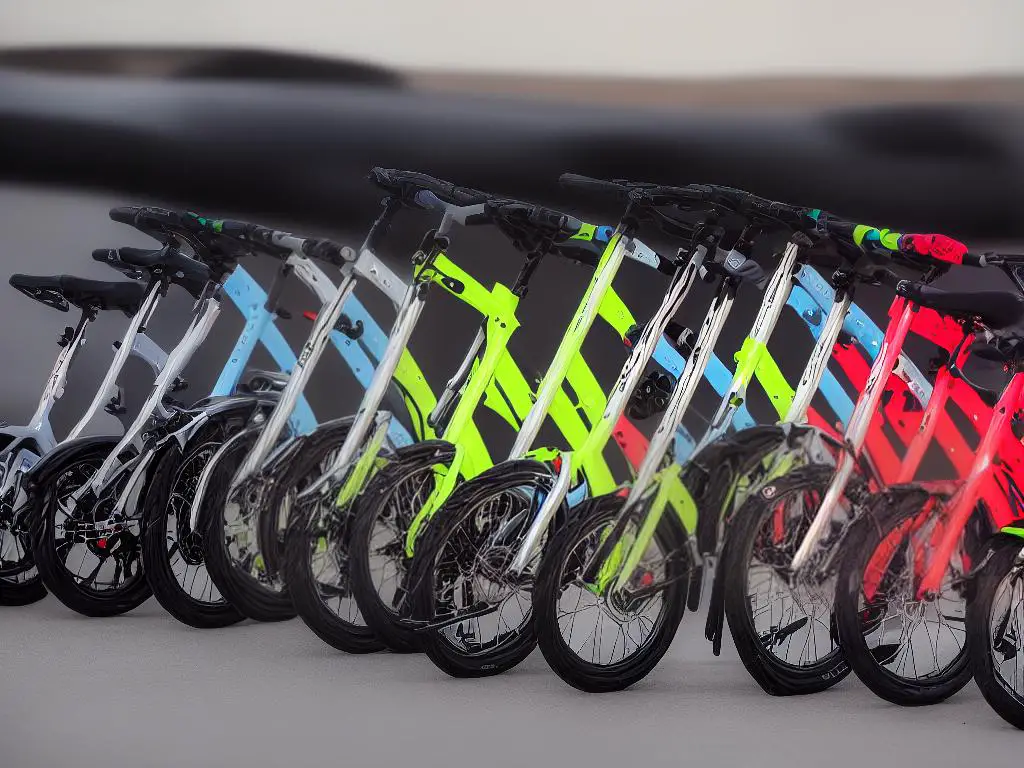Folding Bikes on Public Transportation: Ultimate Guide
Public transportation provides an essential service for many urban dwellers, but combining it with folding bikes can make the daily commute even more efficient. This article delves into the many benefits of using folding bikes alongside public transportation and offers valuable insights for anyone interested in adopting this eco-friendly and practical mode of transport.
Benefits of Folding Bikes
Cost Savings
One significant advantage of using folding bikes in conjunction with public transportation is the cost savings. Commuting with a folding bike allows individuals to save money on gas, parking, and car maintenance in the long run. A person can use their folding bike for the initial part of their commute and then easily fold and store their bike to hop onto a train or bus, avoiding the need to pay for parking or utilize expensive ride-sharing services. Furthermore, using a folding bike in combination with public transportation can render owning a car unnecessary for some people, leading to even greater financial savings.
Sustainability
In addition to cost savings, utilizing folding bikes with public transportation improves sustainability and reduces an individual’s carbon footprint. Cycling produces virtually no emissions and is healthier for the environment compared to driving a car. By incorporating a folding bike into a daily commute, people can reduce their greenhouse gas emissions and decrease their reliance on fossil fuels. This practice contributes to better air quality, while also encouraging healthier, more active lifestyles for commuters.
Convenience
Folding bikes provide an immense level of convenience for those using public transportation, allowing users to avoid common issues such as traffic jams and parking. Most public transport systems can easily accommodate these compact bikes, simplifying the process of transitioning between cycling and using the bus or train. Additionally, folding bikes are easily stored at work or at home, occupying minimal space and removing the need for a bulky bike rack. Ultimately, this convenience allows commuters to save time and reduce stress while navigating their daily routines.

Selecting the Right Folding Bike
Selecting the Right Folding Bike
When it comes to using folding bikes on public transportation, choosing the right model based on size, weight, and budget is essential. Different transit systems may have varying size restrictions for bikes, so it’s crucial to ensure your folding bike meets these requirements. Before making a purchase, confirm that the folded dimensions of the bike fit within the allowed space of the bus, train, or subway you plan to use, so you can enjoy hassle-free commutes on a daily basis.
When considering weight, it is important to remember that you will be carrying the bike during parts of your commute and lifting it onto and off of the public transportation. Therefore, selecting a folding bike that is lightweight and easy to maneuver makes commuting more manageable. Some folding bikes weigh less than 20 lbs, while others might be closer to 30 lbs. Keep in mind that lighter bikes may come at a higher price, so consider balancing weight and cost, depending on your budget.
One crucial aspect to consider when exploring folding bikes for use on public transportation is the bike’s folding mechanism and ease of folding. Folding bikes come with various types of folding systems that differ in complexity and folding speed. It’s essential to determine how quickly you can fold and unfold the bike, as holding up other passengers when boarding or alighting from public transport would be inconvenient. Additionally, evaluating the bike’s durability and performance is vital to ensure a seamless, reliable ride throughout your commute. Examine the quality of the frame, gearing, and braking systems to find the perfect folding bike for your needs.
Folding Bike Brands and Models
Brompton folding bikes
One of the most renowned folding bike brands, Brompton, is widely known for its compact and lightweight design. These British-made folding bicycles are often considered the gold standard for urban commuting. Offering various customizable models, such as the Brompton M6L, S6L, and H6L, riders can choose their preferred handlebar type, number of gears, and color. Designed to be folded and unfolded with ease, Brompton bikes are perfect for daily commuters who rely on public transportation to travel to and from work. The compact and convenient size of Brompton bikes when folded allows for easy carrying onto buses, trains, and subways without occupying much space.
Dahon folding bikes
Another popular folding bike brand, Dahon, offers a wide range of models that cater to different needs and preferences. Known for their affordability and performance, Dahon bikes are designed to be user-friendly, with a smooth and efficient folding process. Among their top models are the Dahon Mariner D8, which boasts an aluminum frame and 20-inch wheels, offering a balance of portability and ride quality; and the Dahon Vybe D7, which features a lightweight frame and 7-speed drivetrain for easy navigation of urban streets. Both models are suitable for commuters who need a portable and easy-to-ride folding bike when taking public transportation.
Tern Folding Bikes: Versatile Commuting Solutions
Tern folding bikes are a popular choice among those seeking innovation and quality in the folding bicycle market. With models such as the Tern Verge X11, riders can enjoy a lightweight frame, 20-inch wheels, and an 11-speed drivetrain for fast and efficient commuting on public transportation. Electric bike enthusiasts are also catered to through the Tern Vektron S10, which features a Bosch motor, hydraulic disc brakes, and an impressively compact folding size for easy transport on buses, subways, and trains. Overall, Tern bicycles’ versatile and user-friendly designs make them an excellent option for commuters who wish to integrate their folding bike seamlessly with their public transportation routines.

Rules and Regulations for Folding Bikes on Public Transportation
Folding Bikes and Public Transportation: Rules and Regulations
As folding bikes grow in popularity for their compact size and ease of use, especially among public transportation users, it’s important to be aware of the relevant rules and regulations for carrying foldable bikes on buses, trains, and subways. Public transit systems across the United States may enforce various guidelines, but there are some common practices observed in several major cities. By staying informed about these requirements and regularly checking updates from your local transit authority, folding bike riders can continue to enjoy the convenience and flexibility of combining bicycle and public transportation commuting.
When to Bring a Folding Bike on Board
One of the most important aspects for riders to consider is when they are allowed to bring their folding bikes on board public transportation. Many transit systems require that bicycles be folded before boarding and stored in designated spaces on-board, which can vary in size and location depending on the specific vehicle being used. Some transit agencies may enforce bike size limitations that could restrict the use of certain folding bikes. Additionally, some public transportation providers limit the hours during which riders can carry their bicycles onto vehicles, particularly during peak rush hours. It is essential for riders to check the regulations for their specific transit system to ensure they are in compliance.
Costs and Safety Concerns
When using folding bikes on public transportation, riders should be aware of any associated costs. While most transit providers allow passengers to carry folding bikes for free, some may charge additional fees or require a special permit. It’s also crucial to ensure that your folding bike is securely held using bungee cords or straps to prevent accidental unfolding and hazards to other passengers.
Being courteous and respectful to other passengers is essential, as is following any instructions provided by transit personnel regarding the placement and storage of folding bikes during the journey. By adhering to these rules and guidelines, riders can confidently and comfortably incorporate folding bikes into their daily commute via public transportation.

Best Practices for Folding Bike Commuters
To further enhance the experience of using folding bikes in combination with public transportation, it’s important to practice proper bike maintenance. This entails regularly cleaning and lubricating the bike’s gears and chain, checking tire pressure, and adjusting the brakes as needed. Moreover, folding bikes typically have small wheels, which makes them more vulnerable to damage from road debris and potholes. As such, it’s important to be mindful of road conditions and avoid rough terrain whenever possible. By maintaining your folding bike and being attentive to potential hazards, you’ll ensure a smooth and seamless daily commute involving both cycling and public transport.
Etiquette is also an essential aspect of folding bike commuting, especially when it comes to utilizing public transportation. Be sure to fold your bike in accordance with the guidelines of the specific transit system you’re using, as different buses and trains may have different policies. Always make sure your bike is folded small and compact to minimize the space it takes up when onboard. Moreover, be mindful of fellow passengers and avoid obstructing aisles, doorways, or seating areas. In case the transportation is crowded, be prepared to wait for the next one rather than forcing your bike into an already congested space.
Lasty, staying safe on the road is a top priority for all cyclists, including those utilizing folding bikes. To enhance your visibility, consider investing in reflective clothing or accessories, and always use front and rear lights during low-light conditions or at night. Keep in mind that folding bikes’ small size might make them less visible to other vehicles, particularly larger trucks or buses. Be vigilant while sharing the road and maintain awareness of your surroundings at all times. Furthermore, always follow traffic regulations, use hand signals, and practice safe cycling habits to minimize risks and ensure a smooth and enjoyable commute.
Ultimately, folding bikes are a convenient, cost-effective, and sustainable solution for navigating the urban jungle. By choosing the right model and adhering to public transportation rules, folding bike commuters can enjoy a seamless transit experience. With a little bit of research, practice, and maintenance, you can reap the benefits of this innovative transportation method and make your daily commute a breeze.

